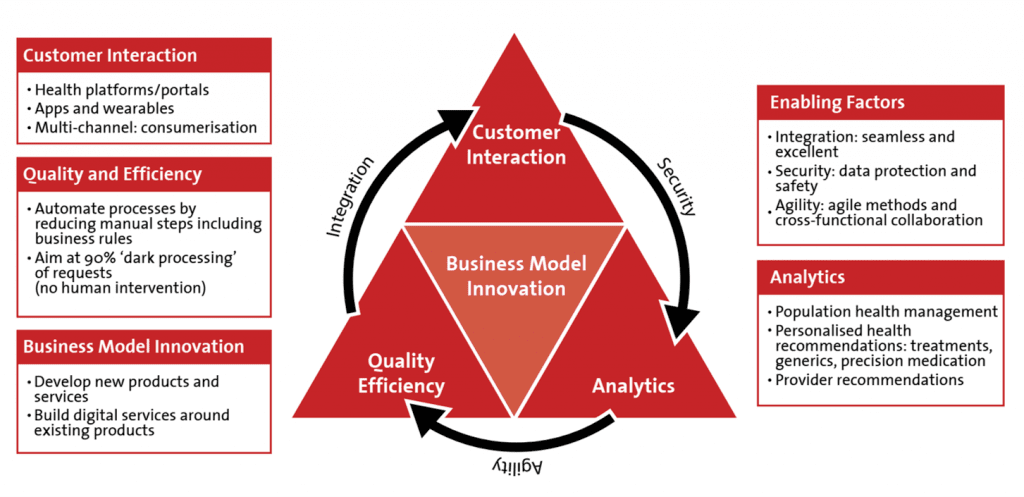Helsana is the leading health insurance provider in Switzerland. The company provides health insurance coverage to around 25% of the Swiss population.
Market and regulatory pressures are increasing in Switzerland, and customer expectations are beginning to shift.
New insuretech players are entering the market with innovative products, while the regulator is pushing for an electronic health record ecosystem. In this situation, Helsana has opted to focus on its core promise: being a ‘health partner’ engaged for life and not just a transaction provider. This promise builds on the company’s core strengths – a strong brand, attractive products, motivated employees, a wide partner network and, most importantly, superior service.
But how can Helsana enrich existing products with digital extensions that would provide added value to its members? How can data insights help consumers improve their understanding of health and make more informed choices? How can the health insurer contribute to reducing healthcare costs while improving the quality of care? Will members even allow the necessary access to their personal data?
At Helsana, business model innovations revolve around improvements in three areas: quality and efficiency improvements in its core systems, analytics to deliver value from information, and improved customer interaction.
The triangle of digitalisation is a framework for identifying opportunities for innovation across all three areas. Enabling factors are security, agile methodologies and integration, with integration seen as a key enabler.
Helsana’s digitalisation journey started with quality and efficiency improvements. In a two-year project, the legacy environment was modernised and transformed into a modular and agile application landscape. After an overhaul of 70% of the company’s administrative systems, the renewed core now supports a higher rate of change, is a sustainable basis for future development and exposes business capabilities as reusable services. Some non-differentiating services are already sourced from cloud providers.

Next up in the digitalisation journey will be the area of analytics, with the creation of a new analytics suite. Insight gleaned from data has tremendous potential in healthcare – to improve the quality of care while driving down medical costs at the same time. Imagine rapid detection of multi-drug interaction issues, recommendations for providers who are highly specialised in your condition, suggestions for alternative treatments, generic pharmaceuticals or precision medication, a personal health coach who steers you towards a healthier lifestyle. All this is feasible on the basis of existing case data and cleverly applied analytics.
Digitalisation goes hand in hand with process, people and culture transformation
A future step will bring significant improvements to the area of customer interaction. Here, analytical insight and core business capabilities are woven into a rich, personalised customer experience and delivered across many channels and devices. The aim is a superior and attractive customer service that members interact with frequently. At the same time, however, Helsana realises that a human touch and a high level of engagement are required. The company can build on its strength of highly qualified and motivated personnel. They are always available when a client prefers face-to-face or telephone interaction, because some situations call for intensive personal and engaged contact. How can Helsana rapidly test innovations in its market while keeping core systems stable and efficient? How does the company create cost structures that can support low-viability products?
How can Helsana leverage its core competencies and co-create innovation with partners and start-ups?
Excellent integration is the key enabler for these principles. Reusable services expose data, insight and functional capabilities from core systems. They also decouple quick front-end innovation cycles from the much slower renewal of the core.
Data integration propagates data from core systems into a 360-degree customer view. Integration replicates master data and analytical insight to cloud services and mobile apps, and improves performance and autonomy.
Bimodal IT revolves around seamless integration of front and core.
Functional integration makes core capabilities available to customer interactions. Secure APIs add an outside-in perspective to business capabilities. They are the basis for ecosystem participation, partner integration and mobile as well as web apps. The forecast sees a push for self-service integration by lines of business.
A market reference model helps Helsana to position digital services. Health platforms, for example, provide services to gauge the quality-of-care delivery, as well as to enable collaboration and more effective care coordination. Providers can benefit from tools to manage the population health of their patient panel. Broker compensation could be reduced through more direct sales. All this optimises care, allows better management of health, provides self-enablement and fulfils the changing expectations of today’s health user. However, it requires integration points and data sharing among insurers, brokers, members and providers.
Here, Helsana puts the concerns of its members centre stage – guaranteed safety of personal health data and ongoing commitment to the solidarity principle in compulsory health insurance.



